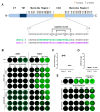Design and Preclinical Evaluation of a Nanoparticle Vaccine against Respiratory Syncytial Virus Based on the Attachment Protein G
- PMID: 38543928
- PMCID: PMC10975092
- DOI: 10.3390/vaccines12030294
Design and Preclinical Evaluation of a Nanoparticle Vaccine against Respiratory Syncytial Virus Based on the Attachment Protein G
Abstract
Human respiratory syncytial virus (RSV) poses a significant human health threat, particularly to infants and the elderly. While efficacious vaccines based on the F protein have recently received market authorization, uncertainties remain regarding the future need for vaccine updates to counteract potential viral drift. The attachment protein G has long been ignored as a vaccine target due to perceived non-essentiality and ineffective neutralization on immortalized cells. Here, we show strong G-based neutralization in fully differentiated human airway epithelial cell (hAEC) cultures that is comparable to F-based neutralization. Next, we designed an RSV vaccine component based on the central conserved domain (CCD) of G fused to self-assembling lumazine synthase (LS) nanoparticles from the thermophile Aquifex aeolicus as a multivalent antigen presentation scaffold. These nanoparticles, characterized by high particle expression and assembly through the introduction of N-linked glycans, showed exceptional thermal and storage stability and elicited potent RSV neutralizing antibodies in a mouse model. In conclusion, our results emphasize the pivotal role of RSV G in the viral lifecycle and culminate in a promising next-generation RSV vaccine candidate characterized by excellent manufacturability and immunogenic properties. This candidate could function independently or synergistically with current F-based vaccines.
Keywords: RSV; attachment protein G; lumazine synthase; nanoparticle; vaccine.
Conflict of interest statement
All authors are employees of Janssen Infectious Diseases & Vaccines and may own stock or stock options in Johnson & Johnson, its parent company.
Figures




Similar articles
-
Respiratory syncytial virus fusion nanoparticle vaccine immune responses target multiple neutralizing epitopes that contribute to protection against wild-type and palivizumab-resistant mutant virus challenge.Vaccine. 2018 Dec 18;36(52):8069-8078. doi: 10.1016/j.vaccine.2018.10.073. Epub 2018 Oct 30. Vaccine. 2018. PMID: 30389195
-
The Respiratory Syncytial Virus (RSV) G Protein Enhances the Immune Responses to the RSV F Protein in an Enveloped Virus-Like Particle Vaccine Candidate.J Virol. 2023 Jan 31;97(1):e0190022. doi: 10.1128/jvi.01900-22. Epub 2023 Jan 5. J Virol. 2023. PMID: 36602367 Free PMC article.
-
Attenuated Human Parainfluenza Virus Type 1 Expressing the Respiratory Syncytial Virus (RSV) Fusion (F) Glycoprotein from an Added Gene: Effects of Prefusion Stabilization and Packaging of RSV F.J Virol. 2017 Oct 27;91(22):e01101-17. doi: 10.1128/JVI.01101-17. Print 2017 Nov 15. J Virol. 2017. PMID: 28835504 Free PMC article.
-
A Recombinant Respiratory Syncytial Virus Vaccine Candidate Attenuated by a Low-Fusion F Protein Is Immunogenic and Protective against Challenge in Cotton Rats.J Virol. 2016 Jul 27;90(16):7508-7518. doi: 10.1128/JVI.00012-16. Print 2016 Aug 15. J Virol. 2016. PMID: 27279612 Free PMC article.
-
Profile of respiratory syncytial virus prefusogenic fusion protein nanoparticle vaccine.Expert Rev Vaccines. 2021 Apr;20(4):351-364. doi: 10.1080/14760584.2021.1903877. Epub 2021 May 2. Expert Rev Vaccines. 2021. PMID: 33733995 Review.
Cited by
-
KD-409, a Respiratory Syncytial Virus FG Chimeric Protein without the CX3C Chemokine Motif, Is an Efficient Respiratory Syncytial Virus Vaccine Preparation for Passive and Active Immunization in Mice.Vaccines (Basel). 2024 Jul 8;12(7):753. doi: 10.3390/vaccines12070753. Vaccines (Basel). 2024. PMID: 39066391 Free PMC article.
-
Prokaryote- and Eukaryote-Based Expression Systems: Advances in Post-Pandemic Viral Antigen Production for Vaccines.Int J Mol Sci. 2024 Nov 7;25(22):11979. doi: 10.3390/ijms252211979. Int J Mol Sci. 2024. PMID: 39596049 Free PMC article. Review.
-
Layer-by-Layer Microparticle Vaccines Containing a S177Q Point Mutation in the Central Conserved Domain of the RSV G Protein Improves Immunogenicity.Viral Immunol. 2025 Apr;38(3):107-119. doi: 10.1089/vim.2024.0084. Epub 2025 Mar 24. Viral Immunol. 2025. PMID: 40126409
References
-
- Nguyen-Van-Tam J.S., O’Leary M., Martin E.T., Heijnen E., Callendret B., Fleischhackl R., Comeaux C., Tran T.M.P., Weber K. Burden of Respiratory Syncytial Virus Infection in Older and High-Risk Adults: A Systematic Review and Meta-Analysis of the Evidence from Developed Countries. Eur. Respir. Rev. 2022;31:220105. doi: 10.1183/16000617.0105-2022. - DOI - PMC - PubMed
-
- Jones H.G., Ritschel T., Pascual G., Brakenhoff J.P.J., Keogh E., Furmanova-Hollenstein P., Lanckacker E., Wadia J.S., Gilman M.S.A., Williamson R.A., et al. Structural Basis for Recognition of the Central Conserved Region of RSV G by Neutralizing Human Antibodies. PLoS Pathog. 2018;14:e1006935. doi: 10.1371/journal.ppat.1006935. - DOI - PMC - PubMed
LinkOut - more resources
Full Text Sources
Other Literature Sources

